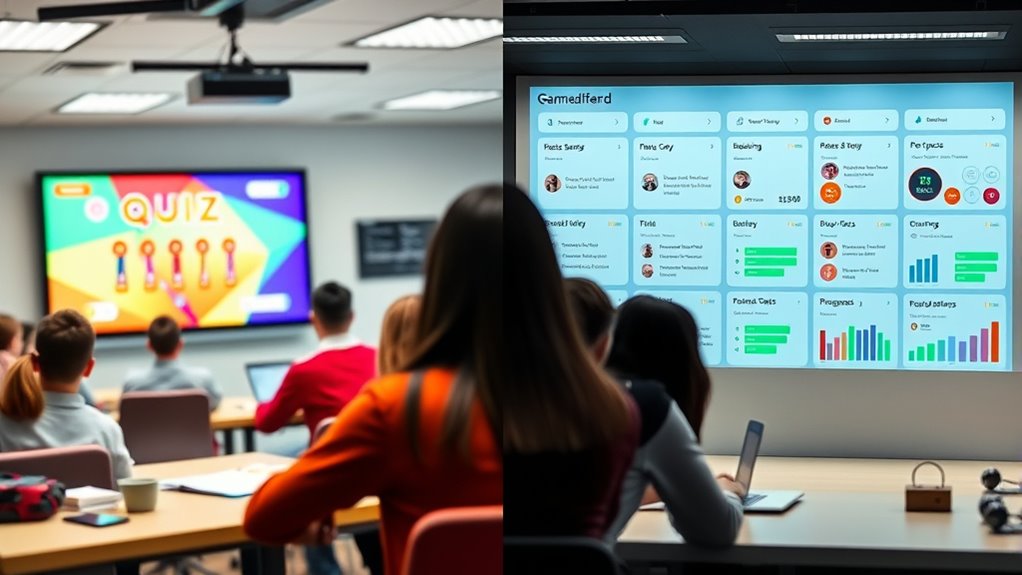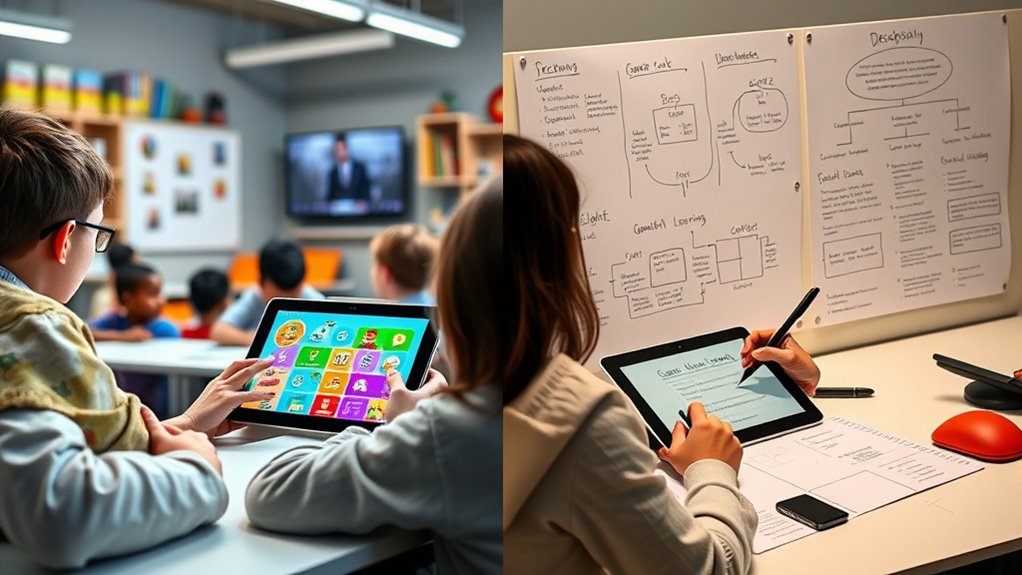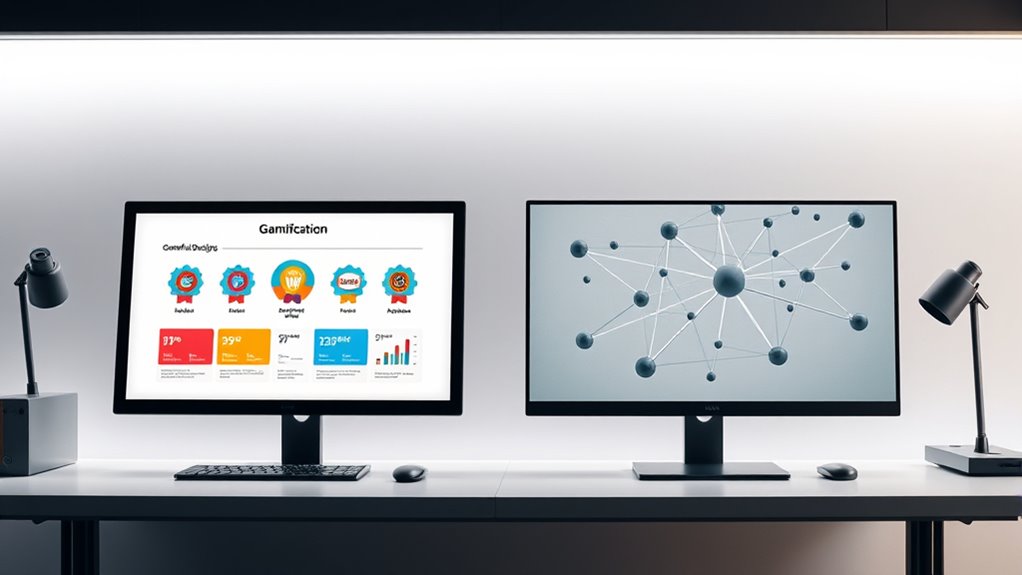Gamification and gameful design are often used interchangeably, but they serve different purposes. Gamification adds external rewards like points and badges to motivate behaviors, mainly aiming for short-term results. In contrast, gameful design creates immersive, meaningful experiences that foster intrinsic motivation and long-term engagement. Understanding these differences helps you choose the right approach for your project. Keep exploring to discover how to apply these strategies effectively and authentically.
Key Takeaways
- Gamification adds external rewards like points and badges, while gameful design focuses on fostering intrinsic motivation and immersive experiences.
- Gamification influences specific behaviors through extrinsic motivators, whereas gameful design creates authentic, emotionally engaging environments.
- Many confuse the two; gamification is about superficial game elements, whereas gameful design emphasizes meaningful, long-term engagement.
- Effective design requires understanding the core principles: gamification targets measurable actions, while gameful design nurtures intrinsic motivation.
- Using these terms interchangeably can lead to misaligned strategies and less authentic user experiences.
Understanding the Core Concepts of Gamification

To understand gamification, you need to grasp its core idea: applying game elements and mechanics to non-game contexts to boost engagement and motivation. This approach leverages principles from motivational psychology, which explains what drives human behavior. By integrating features like points, badges, or leaderboards, you tap into intrinsic and extrinsic motivators that encourage continued participation. Your goal is to make tasks more appealing and rewarding, increasing user engagement without necessarily turning activities into full games. Recognizing this core concept helps you see how gamification transforms routine processes into more compelling experiences. It’s about understanding what motivates people and designing systems that harness those drivers effectively, making engagement more natural and sustained. Additionally, understanding motivational psychology provides insight into designing more effective gamified systems.
Exploring the Principles of Gameful Design

Understanding the principles of gameful design involves recognizing how it intentionally creates engaging experiences by integrating game elements in a way that fosters motivation and enjoyment. At its core, it focuses on enhancing player motivation through meaningful interactions, rather than just adding superficial features. Reward systems play a key role, providing feedback and recognition that reinforce desired behaviors. These systems shouldn’t rely solely on extrinsic rewards but also tap into intrinsic motivators like mastery, autonomy, and purpose. By thoughtfully combining challenges, progress indicators, and social elements, gameful design encourages sustained engagement. The goal is to cultivate an environment where users feel motivated to participate naturally, driven by a sense of achievement and enjoyment that keeps them coming back.
Key Differences in Objectives and Outcomes

Your approach to design shapes what you aim to achieve and how success is measured. With gamification, you often focus on specific behaviors and tangible results, while gameful design emphasizes fostering engagement and intrinsic motivation. Understanding these differences helps you set clearer objectives and evaluate outcomes more effectively. Incorporating educational philosophies into your design process ensures that the purpose aligns with developmental benefits and learning outcomes.
Design Intent and Goals
The primary difference between gamification and gameful design lies in their intent and the goals they aim to achieve. With gamification, your focus is on applying elements rooted in motivational psychology to enhance user engagement within existing systems. It’s about adding points, badges, or leaderboards to motivate specific behaviors. Conversely, gameful design seeks to create a holistic experience that immerses users in a playful environment, fostering intrinsic motivation and enjoyment. Your goal is to craft an experience that encourages exploration, creativity, and meaningful interaction, rather than just extrinsic rewards. While both aim to boost engagement, gamification concentrates on influencing behavior through incentives, whereas gameful design emphasizes cultivating a playful mindset and emotional connection. Additionally, understanding the role of attention in creative practice can help designers develop more engaging and focused experiences that promote sustained user engagement.
Success Metrics and Results
While both gamification and gameful design aim to increase user engagement, their success metrics and outcomes differ considerably. With gamification, you often measure success through engagement metrics like completed tasks, time spent, or participation rates, driven by motivation techniques such as points or badges. These metrics focus on quantifiable behavior changes tied to extrinsic rewards. In contrast, gameful design seeks deeper engagement by fostering intrinsic motivation, leading to sustained interest and meaningful experiences. Its success is less about short-term activity spikes and more about long-term user satisfaction, creativity, and emotional connection. Additionally, incorporating AI-driven personalization can enhance the effectiveness of gameful design by aligning experiences with individual user preferences. Ultimately, while gamification emphasizes immediate behavioral shifts, gameful design aims for lasting engagement rooted in a richer, more immersive user experience.
Strategies and Approaches in Each Methodology

Understanding the strategies and approaches behind gamification and gameful design is essential for effectively applying these methodologies. In gamification, you typically focus on implementing reward systems like points, badges, and leaderboards to motivate engagement and reinforce desired behaviors. These systems tap into extrinsic motivation, encouraging users to complete tasks for tangible incentives. Conversely, gameful design emphasizes integrating narrative elements, such as storytelling and immersive contexts, to foster intrinsic motivation. You craft experiences that evoke emotional engagement, making users feel connected and invested. While gamification relies on external rewards to influence behavior, gameful design creates a meaningful, enjoyable experience that sustains motivation through personal relevance and storytelling. Mastering these strategies allows you to choose the right approach for your goals. Additionally, understanding how to incorporate authentic design elements can significantly enhance user engagement by aligning the experience with real-world values and emotions.
Common Misconceptions and Misuses of the Terms

Many people confuse gamification with gameful design, thinking they’re interchangeable when they’re not. This overlap often leads to misinterpretations of each approach’s true purpose. Understanding these distinctions helps guarantee you apply the right strategy for your goals. For instance, recognizing the Personality Test elements involved can clarify how each method influences user engagement and motivation.
Overlapping Terminology Confusion
The terms “gamification” and “gameful design” are often used interchangeably, but this can lead to confusion and misconceptions. Many assume they mean the same thing, which isn’t true. Gamification typically involves adding game elements like points or badges to boost audience engagement in non-game contexts, often for branding purposes. In contrast, gameful design focuses on creating experiences rooted in game principles to foster deeper engagement and meaningful interactions. Overlapping terminology can cause misunderstandings about project goals, leading you to misapply strategies or misinterpret user needs. Recognizing these differences helps you better tailor your approach, ensuring your use of contextual branding resonates effectively. Clear distinctions prevent miscommunication and improve your chances of building authentic, engaging experiences. Incorporating advanced segmentation techniques can further refine your messaging and optimize campaign performance.
Misinterpreting Design Intent
Misinterpreting the intent behind gamification and gameful design often leads to ineffective or misguided implementations. You might assume that adding reward systems automatically boosts player motivation, but that oversimplifies the goal. Gamification isn’t just about flashy badges or points; it’s about shaping behavior and engagement through meaningful experiences. When you focus solely on rewards, you risk creating superficial motivation that doesn’t foster long-term involvement. Similarly, confusing gameful design with mere game elements can lead to designs that miss the core purpose—encouraging intrinsic motivation. To truly succeed, you need to understand that effective design aligns with user needs and motivations, rather than just piling on rewards. Recognizing the difference between superficial and authentic engagement is crucial for genuine behavior change. Misinterpreting this intent hampers your ability to craft authentic, engaging experiences.
Practical Examples of Gamification Applications

You can see practical examples of gamification in action across various industries, where game elements are integrated to motivate behavior and enhance engagement. Many apps and platforms use reward systems to encourage user participation, such as earning points, badges, or levels for completing tasks. These rewards tap into users’ desire for achievement and recognition. Additionally, narrative integration plays an essential role; embedding a story or theme helps make the experience more immersive and meaningful. For instance, fitness apps often incorporate storytelling elements to motivate users through a journey or mission. By combining reward systems with compelling narratives, organizations create engaging environments that foster sustained interaction and positive behavior change. This approach demonstrates how gamification can be effectively applied outside traditional gaming contexts. Incorporating mental clarity and health concepts into gamification strategies can further enhance user well-being and motivation.
Real-World Instances of Gameful Design in Action

Across various industries, organizations are leveraging gameful design principles to drive real-world impact. They use reward systems and engagement tactics to motivate behavior and enhance user experience. For example, fitness apps incorporate badges and progress tracking to encourage regular workouts, making health goals feel more attainable. Educational platforms implement point systems and challenges to boost student participation and retention. Customer loyalty programs reward repeat purchases with exclusive perks, fostering brand loyalty. In workplace settings, companies introduce gamified training modules that turn learning into interactive experiences. These approaches tap into intrinsic motivation, making routines more engaging and meaningful. Additionally, some organizations incorporate cryptocurrency integration to incentivize user participation and loyalty, reflecting the evolving landscape of digital engagement. By integrating reward systems and strategic engagement tactics, organizations create environments where users are motivated to achieve goals naturally, illustrating the powerful potential of gameful design in real-world applications.
How to Choose the Right Approach for Your Project

Choosing the right approach for your project begins with understanding your goals, target audience, and the behaviors you want to influence. If your aim is to boost user engagement through intrinsic motivation, gameful design often offers a more immersive experience that fosters long-term involvement. Conversely, if you seek quick wins or specific behavioral prompts, gamification’s focus on points, badges, and leaderboards can provide immediate motivational strategies. Consider how your audience interacts with your content—are they motivated by mastery and exploration, or by recognition and competition? By clarifying these elements, you can select the approach that aligns best with your objectives, ultimately creating more effective and engaging experiences tailored to your users’ needs.
Best Practices for Communicating About Game-Related Strategies

Effective communication about game-related strategies hinges on clarity and transparency. To boost player motivation, clearly explain how your design elements support their goals and engagement. Use straightforward language to articulate how rewards, challenges, or narratives enhance the experience. Emphasize narrative engagement by connecting game mechanics to the story or context, making strategies meaningful and relatable. Avoid jargon that might confuse players or stakeholders; instead, focus on simple, direct messaging. Be open to feedback, adjusting your communication to address misunderstandings or concerns. Highlight the benefits of game elements in motivating players and deepening their immersion. By maintaining transparency and emphasizing how strategies support motivation and narrative, you foster trust and enthusiasm, ensuring your audience understands and values your approach.
Frequently Asked Questions
How Do Gamification and Gameful Design Impact User Engagement Differently?
You see, gamification and gameful design influence user engagement differently. Gamification applies reward systems and motivation strategies to boost participation, making tasks feel more rewarding. In contrast, gameful design creates an engaging experience by integrating playful elements that foster intrinsic motivation. By understanding these differences, you can tailor your approach to maximize user interaction and satisfaction, ensuring your strategies are effective and meaningful in capturing attention and encouraging ongoing involvement.
Can These Approaches Be Combined Effectively in a Single Project?
Think of blending gamification and gameful design as weaving a tapestry, where each thread enhances the overall picture. You can combine these approaches through contextual blending, creating a hybrid implementation that leverages the strengths of both. This synergy boosts user engagement, offering motivation and meaningful experiences. When done thoughtfully, it transforms your project into a compelling, immersive environment, seamlessly integrating game mechanics with holistic design for maximum impact.
What Industries Benefit Most From Implementing Gamification Strategies?
You’ll find that industries like corporate training and healthcare applications benefit most from implementing gamification strategies. In corporate training, it boosts engagement and retention, making learning enjoyable. Healthcare uses gamification to motivate patients, improve adherence, and track progress. By applying game elements, you can enhance motivation, foster competition, and increase participation, ultimately leading to better outcomes. These industries demonstrate how gamification can transform traditional approaches into more interactive and effective experiences.
Are There Any Legal or Ethical Considerations in Gamification?
Imagine your gamified system as a vault, guarding sensitive treasures. You must navigate legal and ethical corridors carefully, respecting privacy concerns and avoiding misuse of personal data. Protect users’ information like gold and guarantee intellectual property rights are honored, preventing unauthorized game elements or content theft. By doing so, you maintain trust, uphold integrity, and steer clear of legal pitfalls that could tarnish your reputation and harm your audience.
How Do Success Metrics Vary Between Gamification and Gameful Design?
When evaluating success metrics, you notice that gamification often relies on reward systems to boost user motivation, focusing on specific, measurable behaviors. In contrast, gameful design emphasizes overall engagement and intrinsic motivation, making success harder to quantify. You should consider how these approaches shape user experiences differently, with gamification targeting short-term goals and gameful design fostering long-term involvement through meaningful interactions.
Conclusion
By understanding the subtle differences between gamification and gameful design, you can better choose the approach that gently aligns with your goals. Instead of viewing them as interchangeable, see each as a unique way to subtly enhance engagement. When you select and communicate your strategy thoughtfully, you create experiences that feel natural and inviting. Ultimately, your careful approach helps you craft meaningful, enjoyable interactions that resonate effortlessly with your audience.









